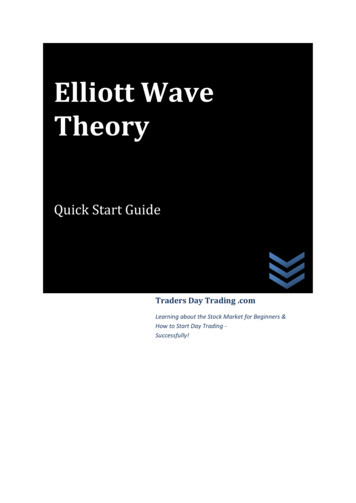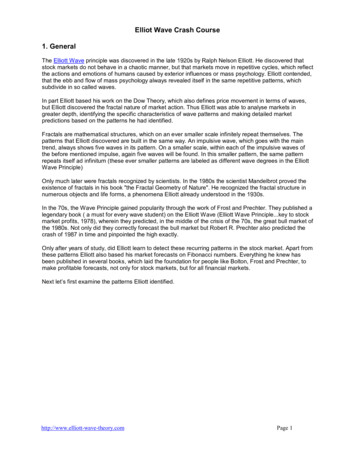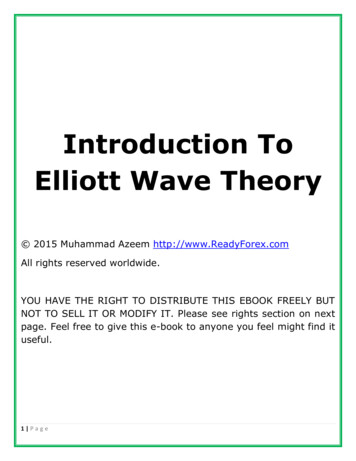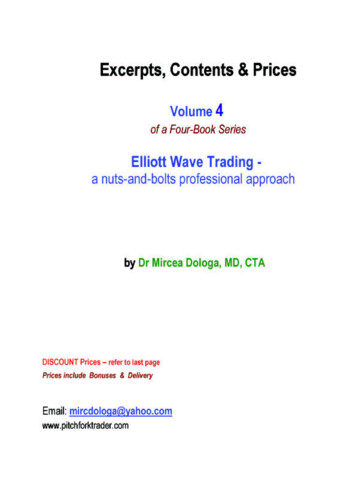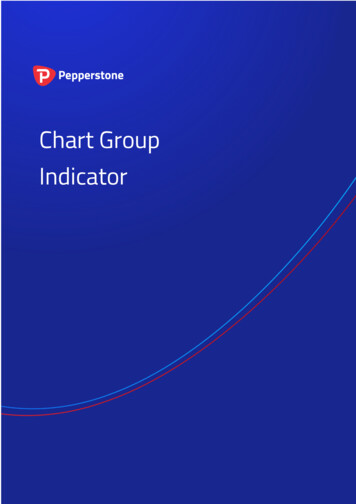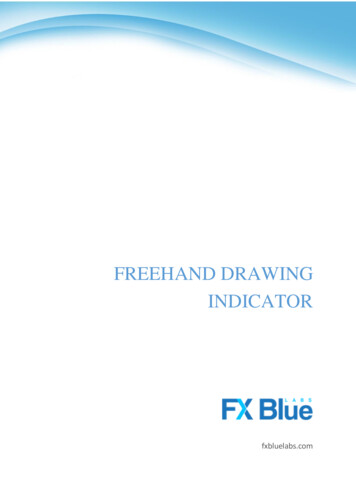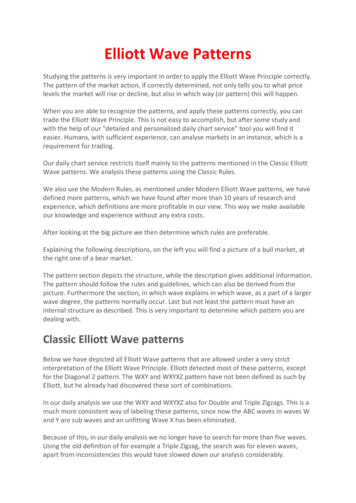
Transcription
Elliott Wave PatternsStudying the patterns is very important in order to apply the Elliott Wave Principle correctly.The pattern of the market action, if correctly determined, not only tells you to what pricelevels the market will rise or decline, but also in which way (or pattern) this will happen.When you are able to recognize the patterns, and apply these patterns correctly, you cantrade the Elliott Wave Principle. This is not easy to accomplish, but after some study andwith the help of our "detailed and personalized daily chart service" tool you will find iteasier. Humans, with sufficient experience, can analyse markets in an instance, which is arequirement for trading.Our daily chart service restricts itself mainly to the patterns mentioned in the Classic ElliottWave patterns. We analysis these patterns using the Classic Rules.We also use the Modern Rules, as mentioned under Modern Elliott Wave patterns, we havedefined more patterns, which we have found after more than 10 years of research andexperience, which definitions are more profitable in our view. This way we make availableour knowledge and experience without any extra costs.After looking at the big picture we then determine which rules are preferable.Explaining the following descriptions, on the left you will find a picture of a bull market, atthe right one of a bear market.The pattern section depicts the structure, while the description gives additional information.The pattern should follow the rules and guidelines, which can also be derived from thepicture. Furthermore the section, in which wave explains in which wave, as a part of a largerwave degree, the patterns normally occur. Last but not least the pattern must have aninternal structure as described. This is very important to determine which pattern you aredealing with.Classic Elliott Wave patternsBelow we have depicted all Elliott Wave patterns that are allowed under a very strictinterpretation of the Elliott Wave Principle. Elliott detected most of these patterns, exceptfor the Diagonal 2 pattern. The WXY and WXYXZ pattern have not been defined as such byElliott, but he already had discovered these sort of combinations.In our daily analysis we use the WXY and WXYXZ also for Double and Triple Zigzags. This is amuch more consistent way of labeling these patterns, since now the ABC waves in waves Wand Y are sub waves and an unfitting Wave X has been eliminated.Because of this, in our daily analysis we no longer have to search for more than five waves.Using the old definition of for example a Triple Zigzag, the search was for eleven waves,apart from inconsistencies this would have slowed down our analysis considerably.
I. Trendsa. ImpulsePatternDescriptionImpulses are always composed of five waves, labeled 1,2,3,4,5. Waves 1, 3 and 5 arethemselves each impulsive patterns and are approximately equal in length. Waves 2 and 4on the contrary are always corrective patterns.Rules and guidelinesThe most important rules and guidelines are: Wave 2 cannot be longer in price than wave 1, and it must not go beyond the originof wave 1.Wave 3 is never the shortest when compared to waves 1 and 5.Wave 4 cannot overlap wave 1, except in diagonal triangles and sometimes in wave 1or A waves, but never in a third wave. In most cases there should not be an overlapbetween wave 1 and A.As a guideline the third wave shows the greatest momentum, except when the fifthis the extended wave.Wave 5 must exceed the end of wave 3.As a guideline the internal wave structure should show alternation, which meansdifferent kind of corrective structures in wave 2 and 4.In which waveImpulse patterns occur in waves 1, 3, 5 and in waves A and C of a correction( this correctioncould be a wave 2, 4 or a wave B, D, E or wave X).Internal structure
It is composed of five waves. The internal structure of these waves is 5-3-5-3-5. Note thatthe mentioned 3s are corrective waves, which should be composed of 5 waves in acorrective triangle.b. ExtensionPatternDescriptionBy definition an extension occurs in an impulsive wave, where waves 1, 3 or 5 can beextended, being much longer than the other waves. It is quite common that one of thesewaves will extend, which is normally the third wave. The two other waves then tend toequal each other.In our pattern definitions we call it an Extension1 if the first wave extends, an Extension3 ifthe 3rd wave extends and an Extension5 if the 5th wave extends.Rules and guidelinesThe most important rules and guidelines concerning an extended wave are: It is composed of 5, 9, 13 or 17 waves.Wave 2 cannot be longer in price length than wave 1, so it should not go beyond theorigin of wave 1.Wave 3 is never the shortest when compared to waves 1 and 5.Wave 4 cannot overlap wave 1.Wave 5 exceeds the end of wave 3.The extended wave normally shows the highest acceleration.In which waveExtensions occur in waves 1, 3, 5, and in A and C waves, when compared to each other.Internal structure
As a minimum it is composed of 9 waves, though 13 or 17 waves could occur. So theminimal internal structure of the 9 waves is 5-3-5-3-5-3-5-3-5. Note that the 3s mentionedare corrective waves, which could be composed of 5 waves in the case of a correctivetriangle.c. Diagonal triangle type 1PatternDescriptionDiagonals are sort of impulsive patterns, which normally occur in terminal waves like a fifthor a C wave. Don¡ t confuse them with corrective triangles.Diagonals are relatively rare phenomena for large wave degrees, but they do occur often inlower wave degrees on intra-day charts. Usually Diagonal triangles are followed by a violentchange in market direction.Rules and guidelinesThe most important rules and guidelines are: It is composed of 5 waves.Waves 4 and 1 do overlap.Wave 4 can¡ t go beyond the origin of wave 3.Wave 3) cannot be the shortest wave.Internally all waves of the diagonal have a corrective wave structure.Wave 1 is the longest wave and wave 5 the shortest.The channel lines of Diagonals must converge.As a guideline the internal wave structure should show alternation, which meansdifferent kind of corrective structures.In which waveDiagonal triangles type 1 occur in waves 5, C and sometimes in wave 1.Internal structure
The internal structure of the five waves is 3-3-3-3-3.c. Diagonal triangle type 2PatternDescriptionDiagonal type 2 is a sort of impulsive pattern, which normally occurs in the first or A wave.The main difference with the Diagonal Triangle type 1 is the fact that waves 1, 3 and 5 havean internal structure of five waves instead of three. Experience shows it can also occur in awave 5 or C, though the Elliott Wave Principle does not allow this. Don¡ t confuse this withcorrective triangles.Diagonals are relatively rare phenomena for large wave degrees, but they do occur often inlower wave degrees in intra day charts. These Diagonal triangles are not followed by aviolent change in market direction, because it is not the end of a trend, except when itoccurs in a fifth or a C wave.Rules and guidelinesThe most important rules and guidelines are: It is composed of 5 waves.Wave 4 and 1 do overlap.Wave 4 can¡ t go beyond the origin of wave 3.Wave 3) cannot be the shortest wave.Internally waves 1, 3 and 5 have an impulsive wave structure.Wave 1 is the longest wave and wave 5 the shortest.As a guideline the internal wave structure should show alternation, which meansthat wave 2 and 4 show a different kind of corrective structure.In which waveDiagonal triangles type 2 occur in waves 1 and A.Internal structure
The five waves of the diagonal type 2 show an internal structure of 5-3-5-3-5.d. Failure or Truncated 5thPatternDescriptionA failure is an impulsive pattern in which the fifth wave does not exceed the third wave.Fifth waves, which travel only slightly beyond the top of wave 3, can also be classified as akind of failure. It indicates that the trend is weak and that the market will show accelerationin the opposite direction.Rules and guidelinesThe most important rules and guidelines are: Wave 2 cannot be longer in price distance than wave 1, so it should not go beyondthe origin of wave 1.Wave 3 is never the shortest when compared to waves 1 and 5.Wave 4 cannot overlap wave 1, except for diagonal triangles and sometimes inwaves 1 or A, but never in a third wave. There should not be overlap between wave1 and A.Wave 5 fails to go beyond the end of wave 3.As a guideline the third wave shows the greatest momentum.As a guideline the internal wave structure should show alternation, which meansdifferent kinds of corrective structures.In which waveA failure can only occur in a fifth wave or a C wave, but normally not in the fifth wave ofwave 3.Internal structureIt must be composed of five waves.II. Correctionsa. Zigzag
PatternDescriptionA Zigzag is the most common corrective structure, which starts a sharp reversal. Often itlooks like an impulsive wave, because of the acceleration it shows. A zigzag can extend itselfinto a double or triple zigzag, although this is not very common, because it lacks alternation(the same two patterns follow each other). Notice that the zigzag can only be the first partof a corrective structure.Rules and guidelines It is composed of 3 waves.Waves A and C are impulses, wave B is corrective.The B wave retraces no more then 61.8% of A.The C wave must go beyond the end of A.The C wave normally is at least equal to A.In which waveMost of the time it happens in A, X or 2. Also quite common in B waves as a part of a Flat,(part of) Triangles and sometimes in 4.Internal structureA single Zigzag is composed of 3 waves, a double of 7 waves separated by an X wave in themiddle, a triple of 11 waves separated by two X waves (see pictures below). The internalstructure of the 3 waves is 5-3-5 in a single Zigzag, 5-3-5-3-5-3-5 in a double.Example of a Double Zigzag
As you have noticed we have a more modern representation of the Double Zigzag using thelabels WXY instead of ABCXABC. This is more consistent, since this way 2 zigzags of lowerdegree get connected to each other by waves of higher degree. On top if that, ourautomatic analysis needed such a consistent method of labeling to reach maximumperformance. Instead of labeling 7 waves (ABCXABC), in our daily analysis we need to labelonly 3 waves (WXY). According to the same method a Triple Zigzag is represented by WXYXZinstead of ABCXABCXABC. This way the number of waves was reduced to five instead ofeleven.b. FlatPatternDescriptionFlats are very common forms of corrective patterns, which generally show a sidewaysdirection. Waves A and B of the Flat are both corrective patterns. Wave C on the contrary isan impulsive pattern. Normally wave C will not go beyond the end of wave A.Rules and guidelinesIt is composed of 3 waves.Wave C is an impulse, wave A and B are corrective.Wave B retraces more then 61.8% of A.Wave B often shows a complete retracement to the end of the previous impulse wave.Wave C shouldn¡ t go beyond the end of A.Normally wave C is at least equal to A.In which wave
It occurs mostly in B waves, though also quite common in 4 and 2.Internal structureAs mentioned before a Flat consists of 3 waves. The internal structure of these waves is 3-35. Both waves A and B normally are Zigzags.c. Expanded Flat or Irregular FlatPatternDescriptionThis is a common special type of Flat. Here the B wave is extended and goes beyond the(orthodox) end of the previous impulsive wave. The strength of the B wave shows that themarket wants to go in the direction of B. Often a strong acceleration will take place, whichstarts a third wave or an extended fifth. If the C wave is much longer then A, the strengthwill be less.Rules and guidelines It is composed of 3 waves.Wave C is an impulse, waves A and B are corrective.Wave B retraces beyond the end of the previous impulse, which is the start of waveA. The C wave normally is much longer then A.In which waveThis corrective pattern can happen in 2, 4, B and X. If it happens in 2 and C is relatively short,normally an acceleration in the third will take place.Internal structureIt is composed of five waves, which have an internal structure of 3-3-5.c. Triangles
Contracting Triangle:PatternDescriptionA triangle is a corrective pattern, which can contract or expand. Furthermore it can ascendor descend. It is composed of five waves, each of them has a corrective nature.Rules and guidelines It is composed of 5 waves.Wave 4 and 1 do overlap.Wave 4 can¡ t go beyond the origin of wave 3.Wave 3 cannot be the shortest wave.Internally all waves of the diagonal have a corrective wave structure.In a contracting Triangle, wave 1 is the longest wave and wave 5 the shortest. In anexpanding Triangle, wave 1 is the shortest and wave 5 the longest.Triangles normally have a wedged shape, which follows from the previous.As a guideline the internal wave structure should show alternation.In which waveTriangles occur only in waves B, X and 4. Never in wave 2 or A.Internal structureIt is composed of five waves, of which the internal structure is 3-3-3-3-3.Expanding Triangle:
Ascending Triangle:This is a triangle, which slopes upwards. This pattern has been implemented in the ModernRules.Descending Triangle:This is a triangle, which slopes downwards. This pattern has been implemented in theModern Rules.Running Triangle:This is a triangle where the B wave exceeds the origin of wave A.d. WXY or CombinationMany kinds of combinations are possible. Below a rather complex example has beendepicted.PatternDescriptionA Combination combines several types of corrections. These corrections are labeled as WXYand WXYXZ if it is even more complex. It starts for example with a Zigzag (wave W), then anintermediate X wave, then a Flat (wave Y) and so on. A so-called double or triple three isalso a Combination, but this pattern combines Flats separated by X waves.
Rules and guidelines All types of correct
Elliott Wave Patterns Studying the patterns is very important in order to apply the Elliott Wave Principle correctly. The pattern of the market action, if correctly determined, not only tells you to what price levels the market will rise or decline, but also in which way (or pattern) this will happen. When you are able to recognize the patterns, and apply these patterns correctly, you can .File Size: 1MBPage Count: 160



